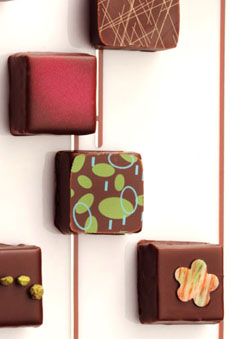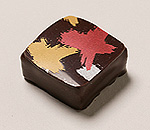 
These gorgeous bonbons from Jin Patisserie of Venice, California, a NIBBLE Top Pick Of The Week, bear zero resemblance to the chocolate first experienced by the Spanish Conquistadors. These: among the most delicious confections in America, are filled with fondant flavors like Ginger, Green Jasmine, Lemongrass and Roasted Black Sesame. The original chocolate was also exotic, but a bitter, unsweetened beverage mixed with pepper, chili pepper, musk, vanilla and cornmeal. It was enjoyed by the Aztecs but so unpalatable to the Europeans, they spat it on the ground.
|
KAREN HOCHMAN’s first word was not cacahuatl...but as her mother will attest, it was pretty close.
|
|
August 2005
Updated January 2009
|
 |
From Pod to Palate Part I: A Brief History Of Chocolate
Page 1: Introduction
The delicious chocolate we take for granted began life as a bitter, unsweetened drink that was unpalatable to the Europeans who first tasted it. Take a brief trip through the history of chocolate. While chocolate has been consumed as a beverage since about 1200 B.C.E., the first chocolate bar wasn’t created until 1847. This is Page 1 of a four-page article. Click on the black links below to visit other pages.
Introduction
Forget what it takes for Kristy Choo, Michael Recchiuti, Christopher Elbow and other masters crafters of “brown gold” to make a brilliant box of chocolate bonbons that looks and tastes like great art. Even the simplest chocolate bar we take for granted is, like many things in the food chain, the result of back-breaking work and hundreds of hours of labor of many nameless people.
Watch the journey of the cacao pods, from trees on plantations in the tropical forest clearings of Africa, South America, the Caribbean and Malaysia, as they become the chocolate you buy. The next time you take a bite you’ll have a deeper appreciation of the long trip that bar, truffle, or other delight has taken.

Christopher Elbow chocolates are
made of Venezuelan criollo cacao
beans–among the finest in the world.
This bonbon is filled with Spanish
saffron-flavored fondant.
Before the trip begins, let’s correct the biggest typo in chocolate history. Cocoa is a transposition of cacao, the original name of the tree and its fruit (the pods that bear the seeds, or beans, that are harvested and roasted to start the chocolate-making process).
The misspelling probably happened on an African trading ship manifest in the 18th century. But for some merchant’s mistake, we’d be drinking a nice hot cup of cacao and mixing cacao with butter, sugar and eggs to make brownies.
Continue To Page 2: The Cultivation Of Cacao
Go To The Article Index Above

|





